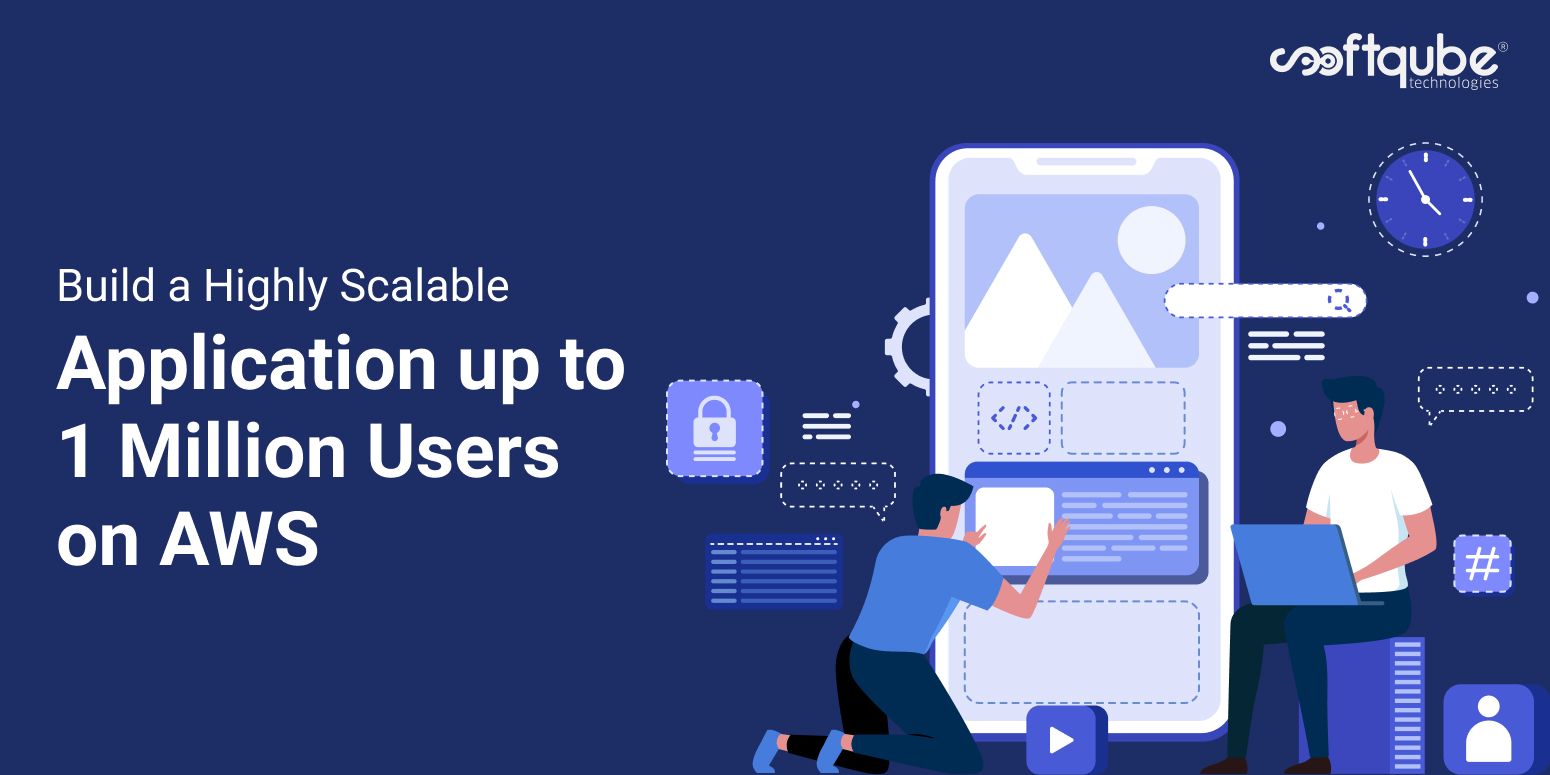Build a Highly Scalable Application up to 1 Million Users on AWS
December 6, 2021

Let us assume that to drive more customer visits, you have fabricated a web application of the administration items you serve, and that is why contrarily you have now started getting very few customers.
You get a few suggestions to improvise with feedback from the users. And you get ready to revamp your application. Your marketing team revamps the app leading to a rise in the number of visitors. And in no time, several hundreds of individuals begin to use your app. And what happens here is, due to a sudden gush of visitors pooling in at the same time, some of them are unable to access your app.
You are no doubt proud of the numbers. But you are now keen to know what turned so bad and why.
Know that your app has stopped working because there is a scalability issue. Your cloud architecture is not supportive enough to handle the rising number of visitors with great efficiency and sufficiency.
Unlike other companies who look forward to features and pay less attention to scalability, you must always go the other way round.
Because they are strong and scalable, both stand to be crucial for any application architecture.
The blog will help you sort out your issue. You will now know how to build scalable application architectures that are highly scalable and can handle upto 1 million users.
What is a Scalable Application?

The capacity of any framework to provide a moderate performance under the rising load of large data, high solicitation rates, speed, etc is termed scalability.
The app should work at its best even if the client is 1 or more than 1 million users using the app at the same time.
Scalable apps capture only important assets to meet tasks by eliminating the sources which are not needed.
While examining scalability in distributed computing, you will usually hear about two main ways of scaling – horizontal or vertical.
How about we dive more into these terms.
Vertical Scaling
This is also known as Scaling up. The asset maximization of a solitary unit is alluded to increase its capacity to control the increasing load.
In hardware terminology, there are additional preparing forces and memory to the physical machine operating the worker.
In software terminology, to scale up means you may rearrange algorithms and application code.
Horizontal Scaling
It is also known as scaling out. It alludes to asset development via adding units to the application’s cloud architecture.
In simple terms, it means adding more and more small capacity units instead of adding a solitary large capacity unit.
And now asset solicitation is expanded widely across several units subsequently dropping the overload on a solitary machine.
Characteristics That Determine If an Application is Scalable or not?
Scalability must resemble some solid means. A few parts where an app requires critical considerations are as follows:
Performance
Bad performance-giving applications, even though scaled, can impact SEO ranking all through the platform. A quick response along with fast recuperation (low latency) is an unquestionable requirement.
Manageability
The framework has to be easy to control, sustain, and update. Issues should be easy to spot. It ought to regularly operate without failures or breaks.
Availability
The site operating time is very important for any company that wants to maintain its reputation. You can consider a large online vendor for just an example. Millions of benefits get lost by not making the site reachable for even a brief timeline. Constant availability will require a planner to consider removal of the key components, to introduce speedy recuperation of framework failures and breaks.
Retrieval Reliability
When any consumer wants data, the same data must get displayed, only in case it is not updated. Users need to believe that when data is put away into the framework, it will be always there on the off chance and can be used again.
Cost
Besides expenses incurred on software and hardware, there is an improvement cost. It takes for the functioning of the framework and training that is necessary. Total expense is what it takes to hold and operate the framework. It’s important to take note that these standards should all be measured yet there may be trade-offs.
Instructions To Build A Scalable Application That Supports 1 Million Users on AWS
Single Client (first arrangement of Cloud architecture)
You are the only one operating the app on the localhost. The initial advancement can be as straightforward as installing an application in a crate. Here, you need to use the accompanying AWS administrations to begin.
Amazon Machine Images (AMI)
Amazon Machine Image (AMI) gives the data required for instance to be launched, which is a virtual worker in the cloud. You can recognize an AMI during the launch of an instance.
An AMI has a template for the root volume for the instance, giving approvals that control which AWS accounts can utilize the AMI to launch instances. Apart from that, a square gadget mapping determines the volumes to be attached to the instance when it’s launched.
Amazon Elastic Compute Cloud (Amazon EC2)
Amazon Elastic Compute Cloud gives the scalable processing facility in the AWS cloud. This eliminates the hardware upfront with the goal that you can create and install applications easily.
Amazon Virtual Private Cloud (Amazon VPC)
Amazon Virtual Private Cloud offers assistance to launch AWS assets in a virtual organization. It gives you full control over the virtual systems administration atmosphere including picking of IP address range, subnet plan, the arrangement of course tables, and organization gateways.
Amazon Route 53
Amazon Route 53 is a profoundly accessible and scalable cloud DNS web administration. Amazon Route 53 proficiently consolidates client solicitations to infrastructures running in AWS –, for example, Amazon S3 containers, Amazon EC2 instances, or Elastic Load Balancing load balancers.
Here you need an advanced box. You can essentially pick the larger instance type which is called vertical scaling. At the initial stage, vertical scaling is sufficient yet we can’t scale vertically for eternity.
Eventually, you’ll hit the stopping point. Also, it doesn’t address failover and repetition.
USERS > 10 (Create numerous hosts and select the database)
To begin with, you need to choose the database as users start increasing and generating data. It’s insightful to start with SQL Database initially because of the accompanying reasons:
Perceived and very much worn innovation.
Network upload and moving apparatuses.
It won’t break SQL DBs in the initial 10 million consumers.
USERS > 100 (Store database on Amazon RDS to ease the cycle)
At the point when users are more than 100, Database organization is the main thing that should be done. There are two common directions to install a database on AWS.
The primary option is to utilize a guided database administration, for example, Amazon DynamoDB or Amazon Relational Database Service (Amazon RDS) and the second step is to have your own database software on Amazon EC2.
Amazon RDS
Amazon Relational Database Service (Amazon RDS) gives such a huge amount of ease to arrange, manage, and scale the relevant database in the cloud. Amazon RDS has six common database motors to choose from, similar to Amazon Aurora, Oracle, Microsoft SQL Server, MariaDB, PostgreSQL, and MySQL.
Client > 1000 (Create many availability zones to improve availability)
Based on the current architecture, you may face accessibility issues. On the off chance that the host for your web app ignores, at that point it may go down. So you ought to have another web instance in another Availability Zone where you will place the slave database to RDS.
Elastic Load Balancer (ELB)
ELB expands the approaching application traffic across EC2 instances. It is horizontally scaled, requires no bandwidth limit, gives SSL termination, and executes health checks with the goal that only healthy instances get traffic.
This cycle has 2 instances behind the ELB. We can get 1000s of instances behind the ELB. This is Horizontal Scaling.
Users: 10,000s – 100,000 (Shift static content to protest based storage for good performance)

Add more read replicas to RDS to enhance performance and effectiveness. This will take the weight off the compose master database. Also, you can decrease the load from web workers by moving static content to Amazon S3 and Amazon CloudFront.
Amazon S3
Amazon S3 is an article-based storage space. It isn’t attached to the EC2 instance which makes it the best to store static content, like javascript, CSS, images, and recordings. It is intended for 99.999% of stability and can store numerous petabytes of information.
Amazon CloudFront
Amazon CloudFront is also called Content Delivery Network (CDN). It recuperates data from the Amazon S3 container and spreads it to many data community locations. It stores content at the boundary locations to furnish consumers with the least latency rate.
Users > 1 million (Use Service Oriented Architecture (SOA) for good adaptability)
To serve more than 1 million users, you need to utilize Service Oriented Architecture (SOA) while making large-scale web applications.
In SOA, we need to separate each component from the particular levels and create separate administrations. The individual administrations can then be scaled separately. Web and application levels will have distinctive asset needs and various administrations. This gives you a ton of adaptability for scaling and high accessibility.
AWS offers a large group of conventional administrations to help you build SOA infrastructure quickly. They are:
Amazon Simple Queue Service (SQS)
It is an easy money-making administration to decouple and coordinate the components of a cloud application. Utilizing SQS, sending, putting away, and accepting messages can be performed easily between software components of any size.
Amazon Simple Notification Service (SNS)
You can send messages to countless supporters with SNS. Its benefits are easy installation, smooth functioning, and high dependability to send notifications to everyone.
AWS Lambda
It is a register administration that allows you to run code without maintaining or managing workers. AWS Lambda measures your code only when it is required and scales automatically, from a small number of solicitations every day to thousands every second.
There is no charge when your code isn’t functioning. You only pay for the calculated time you consumed. You can also build serverless architecture made out of functions that are generated by occasions.
Final Thoughts
It takes several days and maybe months to learn how to build scalable sites. You need a lot of practice and a considerable amount of money via investing more energy. And then you get popular.
Slow working pages can leave a negative impact on the users’ minds. Unhappy users may never come back and above and all this leads to a bad reputation and eventually affects your business.
Create highly scalable websites and applications and increase your scalability by hiring a team of efficient, knowledgeable and experienced web experts. At Softqube, our team is supportive and highly eligible to cater to your problems and serve the best of the solutions for your business growth. Contact us now!
Share on









